"An unwillingness to admit the possibility that mankind can have any rivals in intellectual power occurs as much amongst intellectual people as amongst others: they have more to lose." - Alan Turing
The Big Brother Universe
This page examines the theory that our universe is the construction of some advanced civilisation - not as improbable as it might appear! In fact, it would be surprisingly simple to create intelligent life:
"Hydrogen is a light, odourless gas, which, given enough time, turns into people."
- Edward R.Harrison, Cosmologist
How practical would it be to make a universe of your own, a universe capable of sustaining life? If you want to know how to make your own universe in a laboratory, MIT's Edward Farhi, Alan Guth, and Jemal Guven have produced a recipe. It basically involves compressing a 10-kilogram sphere of mass to an extremely high density. The ball would implode usually forming just a black hole. Occasionally, though, it would branch off by quantum tunnelling to create a baby universe hidden inside the black hole. This branch could grow to a large size without interfering with the laboratory (see this New Scientist article).
It sounds so easy! Well, maybe not easy, but it would be well within the ability of a advanced civilisation. Just think of the technological progress of human civilisation over the last thousand years and consider where we might be in a million years (assuming we don't blow each other up). In fact - if the universe is already teeming with life as some suggest - the technology might well be in existence already, somewhere "out there".
Edward R. Harrison, a cosmologist at the University of Massachusetts has proposed an ingenious theory explaining the proliferation of universes which may be amenable to the development of intelligent life (see this Smithsonian article). He assumes that if sufficiently advanced civilisations had the capability to create universes then some of those universes would be of a form conducive to intelligent life evolving within them. Those inhabitants of the new baby universe will eventually evolve to become sufficiently advanced to create baby universes of their own, and so on. Universes unfit for habitation would lack intelligent life and would not be able to reproduce, so we end up with a form of "natural selection" producing a series of universes containing life.
The Simulation Argument
But maybe there is a simpler way to create your own "universe", a method which utilises our extraordinary advances in computer technology. In an imaginative paper entitled The Simulation Argument, Oxford University philosopher Nick Bostrom has presented an argument that it is quite possible we are living in a computer simulation similar to that depicted in the film The Matrix. Though the world feels "real" to us, we might be merely logic states in an advanced computer.
It's very hard (if not impossible) to disprove this "Matrix" theory (see the "Brain-in-a-Vat" Argument). This is because our notion of "reality" is so loosely defined: our human sensory inputs form the easily-fooled last link in the chain of our cognition, but we rely on those senses to define the nature of all our reality. Forget Gödel's Theorem and the Heisenberg Uncertainty Principle: the Brain-in-a-Vat argument tells us everything we need to know about the limitations of science, mathematics, and our possible knowledge of the universe. Put simply, we can never know anything for certain. We might be living in the Matrix, or be a brain-in-a-vat with all our sensory inputs being faked, and we would have absolutely no way of knowing. David Deutsch: "From the point of view of science it's a catastrophic idea, the purpose of science is to understand reality. If we're living in a virtual reality we are forever barred from understanding nature." (see here).

The Simulation Argument is ambitious in that it takes this idea one step further. It doesn't just say "We might be in the Matrix", it uses evidence gathered from the world around us (about the rapid growth of our computer technology) and solid scientific reasoning to show that a rational scientific person has to take seriously the possibility that we are already living in the Matrix.
The basic principle behind this theory is that the human civilisation will one day have access to sufficient computing power capable of running simulations of their ancestors (us!). Maybe in a few thousand years in the future we might actually make a re-appearance (as Sims) in those advanced simulations. That doesn't sound too far-fetched, does it? But what if it is the case that human civilisation has, in fact, already reached that advanced state and is already running those simulations? That would mean we are in the Matrix right now!
In fact, the future human race could easily create Matrices containing astronomical numbers of simulated beings (this has the ring of truth to it: when you run "The Sims" there's only one of you, but the program contains thousands of Sims). There is therefore a possibility that the number of conscious, simulated humans will one day become very much larger than the number of real humans.
The Simulation Argument then goes one step further by stating that with the number of simulated humans inevitably outnumbering real humans, the Matrix scenario is actually the most probable situation (unless you think the human race is going to become extinct pretty soon, or we're going to get bored with "The Sims" and start playing "Tetris" again - both of which seem quite unlikely).
To sum up, the Simulation Argument is a rigorously-presented argument which means that a rational, scientific person considering the extraordinary recent increase in computing power available to us, now has to treat seriously the possibility that we are already living in the Matrix.
The Need for Constraints
Purely from a practical point of view, it would prove essential to impose some constraints on the abilities of your Sims. This is to avoid logical inconsistencies which would have a calamitous effect on your computer simulation. For example, if you allowed your Sims to travel back in time you would have to deal with "killing your own grandfather"-type paradoxes. There would be nothing to stop you programming time travel functionality into your simulation. You have complete freedom in that respect: you're effectively omnipotent in what you can allow. But "with great power comes great responsibility" (as Spiderman would say). You would need to constrain such behaviour or the resultant logically-inconsistent scenarios could bring down your entire simulation.
In order to clarify the dangers, let's imagine the situation of going back in time (say, from the year 2007 back to the year 1950) and killing your father before you are born. Once you have committed the murder, the simulation would need to determine the implications of the event. For example, if the simulation wants to display the situation in the year 1970, say, it will have to consider the effect of that murder back in 1950. The problem is that the implications of the paradoxical murder can never be established in a satisfactory and unambiguous form.
Because of the sequential nature of computer programming, in order to
calculate the effect of the murder we could break down the required computer
simulation processing into four steps:
a) Initially, a
"father" object is created and, in time, the father object produces a "son"
object (function father_constructor()
is called to construct a father object (object-oriented programming) and that
function in turn calls the son_constructor()
function to construct the son object).
b) The effect of
creating the son object has a calamitous effect on the father object (as the son
goes back in time and kills the father). So function son_constructor()
calls the father destructor.
c) When the father is
killed, he cannot produce his son. So function father_destructor()
calls the son destructor (the son is never constructed).
d) If the son is never produced then there is now
nothing to kill the father. So function son_destructor()
calls the father constructor.
Here are the four resultant functions:
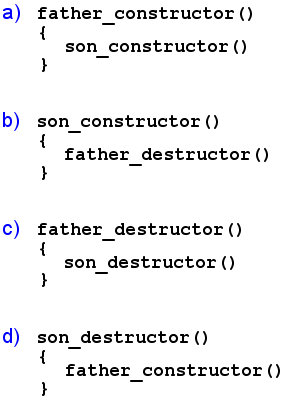
If you consider the functions you will see that each function will call the
next in a cyclic manner:
A => B =>
C => D => A =>
B => C ...
The sequence never terminates. In the computer simulation, this will manifest itself as an infinite loop. This will crash the entire computer simulation! To see the simulation running (trapped in an infinite loop), click the button below:
Waiting to start simulation
(To view the actual JavaScript code used in this simulation, see patricide.js)
In order to avoid these practical problems, you would unfortunately feel the need to impose a constraint on your Sims to prevent time travel behaviour (something along the lines of Stephen Hawking's chronology protection conjecture). It would spoil your fun a bit, but you would effectively have no choice. You would have to rein in your omnipotent freedom a bit and apply some constraints to your simulation (ensuring logical inconsistencies are impossible). Constraints would be necessary to produce a quality universe capable of interesting, complex interactions (some of the more complex processes might even arrogantly describe themselves as "life"!). It's all reminiscent of the way we have to impose laws on society or else we would just be left with a useless, anarchic mess (which even the criminals would find undesirable!).
(This need to apply constraints to a completely unconstrained environment (in order to produce a tenable universe) has important ramifications for the "anything goes" interpretation of the Anthropic Principle. See "And now ... the Ultiverse!" in the page on The Anthropic Principle.)
Spacetime in a Simulation
Relativity and quantum mechanics are the two most fundamental and important theories known to physics, and, as such, any theory that suggests we might be living in a computer simulation would have to provide an explanation for their presence. However, both of these theories are problematic for computer simulation theories because they would both appear to be totally unrelated and unneccessary for any simulation of human behaviour (I bet the programmers of The Sims, for example, don't bother coding-in relativistic or quantum mechanical features). The next couple of sections considers relativity and quantum mechanics in a simulation, starting with a discussion about time.
There are two dominant - and incompatible - theories of time: the tensed theory, and the tenseless theory. The tensed theory of time most resembles the popularly-held view of time. The tensed theory requires there to be a present moment (the "now"), and a distinction between an event in the past, present, and future (an event in the past was real, an event in the present is real, and an event in the future will be real). Notice that the "now" moves. This apparent movement of the "now" is an essential feature of the tensed theory of time.
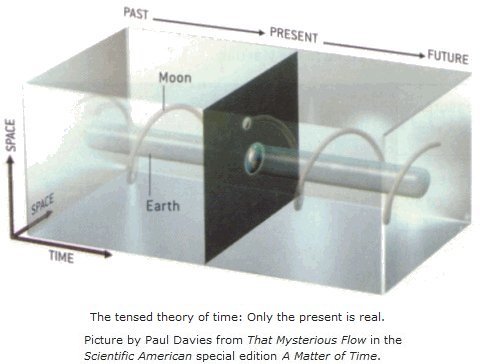
However, the Cosmic Universe page showed how the Wheeler-DeWitt equation suggested a universe in which all of time is laid-out (just as the space dimension is laid-out), and there is no moving "now". All times are equally real: as there is no special "now", there is no distinction between past and future. This forms the tenseless theory of time. The apparent flow of time is considered to be just an illusion of human perception (due to the asymmetry of the time dimension - see the Cosmic Universe page for a discussion on the Arrow of Time).
Most physicists would favour the tenseless theory as the most accurate representation of time. It is also called block time because all of spacetime can be viewed as being laid-out as an unchanging four-dimensional block:
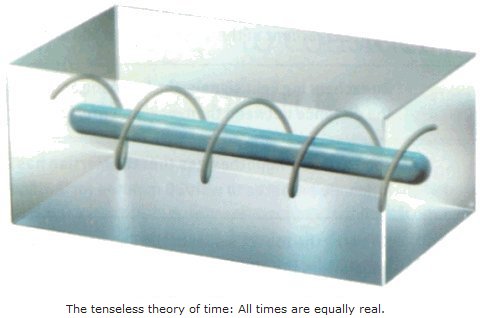
For more information about this, see this Scientific American article by Paul Davies.
McTaggart's argument against the tensed theory of time
In The Unreality of Time (1908), the Scottish philosopher John Mc Taggart presented an argument against the tensed theory of time which still appears to dominate discussions of time in the philosophical community. McTaggart considered the tensed theory in a very fundamental way and wondered what it was that made an event have the property of being "in the past" or "in the future". He realised that over the course of history all events had both of those (logically incompatible) properties. For example, the sinking of the Titanic is "in the future" if you were to consider it from the year 1800, but it is "in the past" if you were to consider it from the year 1950. You might not see the problem with this: clearly, an event does not have the property of being both "in the past" and "in the future" at the same time. But by saying that you are implicitly acknowledging the importance of there being a clearly-defined "now" value in order for the tensed theory to work, in order to clearly identify whether an event should be considered "in the past" or "in the future". This shows the vital importance of the "now" to the tensed theory.
However, McTaggart realised that there was nothing in the tensed theory to explain where this "now" value is supposed to come from, and at what speed it supposedly moves (these problems do not afflict the tenseless theory as it requires no such "now" value). McTaggart showed that any attempt to define a "now" resulted in infinite regression (McTaggart called it a "vicious circle"). This crucial last part of McTaggart's argument can be best illustrated if we consider the problem of time within a simulation.
McTaggart's objection to the moving "now" is related to a question which has puzzled philosophers: "How fast does time flow?" (see here). If the "now" moves then it must move with respect to some time reference. So is it moving with respect to itself? Surely not. To say "Time moves at the rate of one second per second" is meaningless. Rather, the rate of time flow would have to be measured with respect to some secondary, external time reference. Throughout the page on The Cosmic Universe it was stressed that there was no clock outside the universe, so there could not be any such external time reference. However, now we are considering a simulated universe we discover - quite conveniently - that we can postulate a time reference external to our universe: we finally have that "clock outside the universe"! This could be pictured as the master clock of the microprocessor performing the simulation.
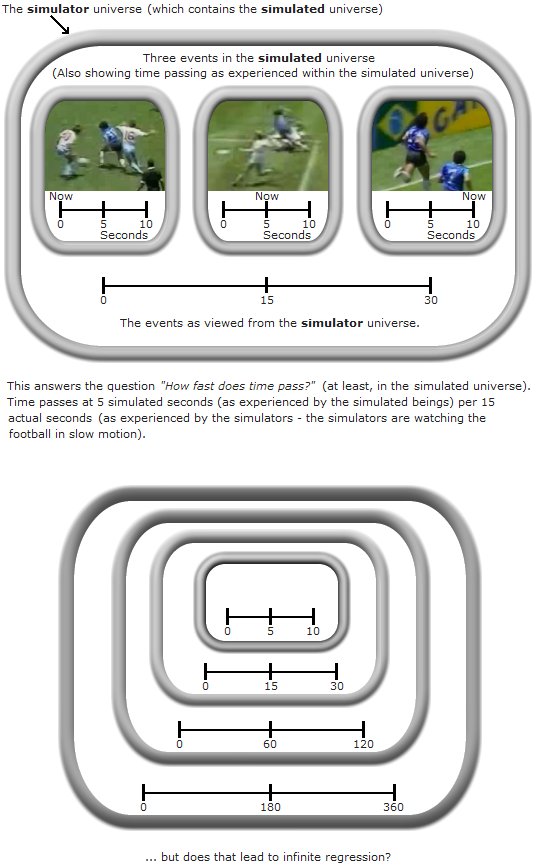
However, we're not out of the woods yet. The question now arises "How fast does time pass in the simulator universe?". Do we have to propose a secondary simulator universe outside of the simulator universe in order to provide us with yet another time reference - a simulation within a simulation? Surely that would lead to infinite regression: an infinite series of simulations within simulations. McTaggart realised this continual "stepping-back" could never provide a solution to the problem of the "now" (he called it a "vicious circle", though it's not really circular - it's infinite regression). McTaggart declared that this meant the tensed theory of time was logically inconsistent, but I would say the tensed theory is merely incomplete (rather than the killer-blow of being inconsistent): it just needs some additional mechanism to provide the "now", such as the mechanism just illustrated.
So the structure of a simulated universe seems to give new life to the tensed theory of time, and, indeed, the tensed theory would seem to be a likely contender for the nature of time within a simulation: after all, why expend effort retaining full, detailed models of the entire past and future when only the present can be displayed on your computer simulation (I would imagine this is how most conventional simulations - such as The Sims - are coded). The "now" would be represented by the computer's current state of the simulation. Thus it could be said that only the "now" has any form of reality in that it is currently being represented - as states in a microprocessor - in our physical world.
The precise value for the "now" (which is set by the simulator) now becomes a crucial free parameter which has similarities with the parameters which are said to be set in The Anthropic Principle. If the simulator sets a value too close to the start of the universe (say, 500 million years) then the resultant universe might be rather featureless and lacking in life. It would seem far more likely that he turns the dial to the 21st century at which point he finds the simulated beings starting to discuss the possibility that they might be living in a computer simulation, and figuring-out the secrets of the simulation. How fascinating that would be!
Relativity in a Simulation
Another objection to the tensed theory has been raised on the basis that it is incompatible with special relativity (see the Rietdijk-Putnam Argument). Special relativity says that the rate at which time passes can be different for each individual, dependent on their relative motion (due to time dilation - see here). Hence there is no such thing as a global time - one clock for every person in the universe. But if there is no global time, how can there be a single "now" for the entire universe? With the tensed theory so dependent on the principle of the "now", how can the tensed theory survive relativity? The function of the "now" in the tensed theory is to turn the unreal future into something real. However, observer-dependency in special relativity means that some events are in the present for some observers (i.e., real) but still in the future for other observers (i.e., unreal). How can an event be both real and unreal?
I don't believe the Rietdijk-Putnam Argument kills the tensed theory of time, but it does show how the tensed theory has to be modified to accommodate special relativity. We should not be concerned about the lack of a global time: the only time with any physical significance is local time - the time as experienced by a particular (specified) individual. It doesn't matter if you are in bed getting woken by your alarm clock, or in a spaceship travelling at near the speed of light, local time (or, more correctly, proper time) is the only time with any relevance to you, the only real measurement of time in the universe.
Once we understand that the only time is proper time, "most of the interpretative problems of special relativity drop away" (see here). We can still have a "now", but it will be represented in proper time for a particular observer. For example, you might say "The time is now 10 o'clock" - that's a statement of the "now" in your personal, proper time. You can still retain the concepts of past, present, and future, but they are specific to a particular observer - they should no longer be regarded as global for the entire universe.
We can understand the concept of the "observer" in a computer simulation by the analogy with the rendering process in computer graphics. Rendering is the process of producing a two-dimensional image on a rectangular viewport (essentially, the computer screen) from a three-dimensional mathematical model (see here):
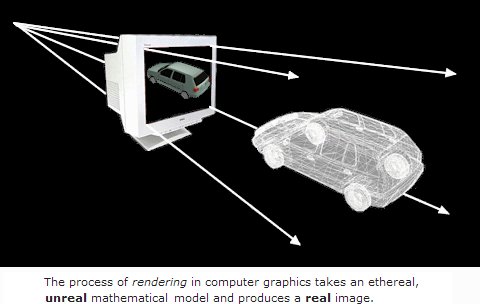
When we have this analogy we find that this concept of proper time for a specific observer once again ties in very nicely with the idea of a simulated universe, because in order to produce a view of the simulation on a simulating computer screen we would have to specify the position of our computer's viewport within the simulation. In that way, we are indeed specifying a particular "now" for a particular observer, and we would take the proper time of that particular observer to represent time in our simulation:
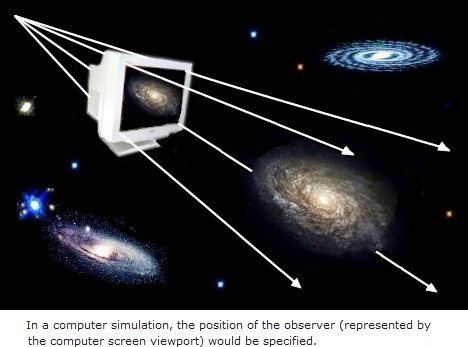
Note that "reality" as perceived by each observer could be subtly different in that the time-ordering of events could be different for each observer due to special relativity. Some events are in the present for some observers (i.e., real) but still in the future for other observers (i.e., unreal, only "existing" as a mathematical model). We have different "realities" - and different "nows" - for each observer. In fact, this is the most efficient method of simulation: reality is created "on demand" only after an observer position is defined.
This principle is called point-presentism. For more information read James Harrington's paper which describes point-presentism in depth and presents a general review of time theories (see here).
It is also interesting to consider the ideas of James Hartle who imagines "Information Gathering and Utilising Systems" or IGUs (humans, basically) embedded in 4D spacetime: "The present is not a moment of time in the sense of a spacelike surface in spacetime. Rather there is a localized notion of present at each point along an IGUS' world line." - see this New Scientist article or arXiv paper gr-qc/0403001: The Physics of 'Now'.
Time Dilation: The "Glitch"?
The previous example has shown how reality in a simulation could be generated on a per-individual basis (in a process reminiscent of rendering in a computer graphics system). The role of the observer is crucial: everything is calculated relative to the inertial frame of reference (the viewport) of the computer-simulated observer.
The microprocessor performing the simulation would have to be astoundingly fast, but it would still have a finite limit on how fast it could process information: the speed of light, no less. As one of the key factors in the rendering process, the speed of light would be one of those properties calculated relative to your inertial frame (viewport). The result of this would be in accordance with special relativity: the speed of light is the same as measured in all inertial frames. This would be highly-desirable as it would be necessary to produce a quality, undistorted image of the simulation, especially if your inertial frame was travelling extremely fast within the simulated universe ("According to the principle of general covariance, a theory must give the same results not matter how you move its coordinate system around in the universe" - quote taken from the Cosmic Universe page). In that case, if you had global time and an absolute (rather than relative) speed of light you would frequently find yourself "out-running" light rays, introducing terrible distortion into your imaging. It's as if our universe was designed to maintain the quality of the viewing experience when travelling at extremely high speeds.
Nick Bostrom has suggested that tell-tale programming flaws in a simulated universe could expose the truth about the simulation to the simulated beings: "Déjà vu is a sign of a glitch in the Matrix ... One person, for instance, told me that he could see flickering pixels when he looked in his bathroom mirror" (see here). John Barrow has continued this theme suggesting that we might expect to see occasional glitches and small drifts in the supposed constants and laws of Nature over time (see here). Might not the distortion of time dilation (time passes at different speeds in different inertial frames) be considered a glitch? It's not such an obvious "bug" as a missing pixel, but then you wouldn't expect to see something so shoddy as a missing pixel in such a sophisticated simulation. Time dilation could be considered more of a deliberate "design trade-off": it benefits those who might wish to travel at speeds near the speed of light (the simulators, as they zoom their viewports around the universe) while being an almost unnoticeable flaw for those who travel at low speed (the simulated beings).
As John Barrow has said: "The flaws of Nature are as important as the laws of Nature for our understanding of true reality."
Quantum Mechanics in a Simulation
The question has been asked "What purpose would be served by simulating events at the quantum mechanical level?" For example, in his book Quantum Reality, Nick Herbert wonders what is the point of quantum non-locality (for a discussion of quantum non-locality, see the page on Quantum Entanglement): "If all the world's phenomena are strictly local, what need is there to support local phenomena with a non-local fabric? Here we confront an alien design sense bizarre by human standards: the world seems strangely overbuilt."
I was one of the contributors to a highly-speculative discussion on this topic which considered if quantum mechanics might be an artifact of the underlying simulating computer system - see here. However, the most surprising similarity between quantum mechanics and computer simulation technology is revealed when we consider computer graphics rendering techniques, considered next:
The CGI Universe
We are all aware of the tremendous advances which have been made in computer generated imaging (CGI) over the last few decades. Astounding photorealistic images are now commonplace in movies such as The Matrix. It would be very important to generate the highest-quality visuals in any computer-simulated reality (in order to fool the participants). The most accurate rendering algorithm is ray tracing.
Ray tracing works - as its name suggests - by tracing individual rays of light emitted from light sources as those rays bounce off reflective surfaces. Ray tracing is especially useful for generating photorealistic images involving multiple reflections or shadows. Ray tracing is the only way to achieve perfect photorealism, and would therefore be the chosen method in any potential computer-simulated universe: "Implementing the rendering equation gives true photorealism, as the equation describes every physical effect of light flow. - see here.

You might imagine that ray tracing would work by tracing all possible rays from a light source to the eye (or computer viewport), taking into account any reflections of those rays off any intermediate objects:
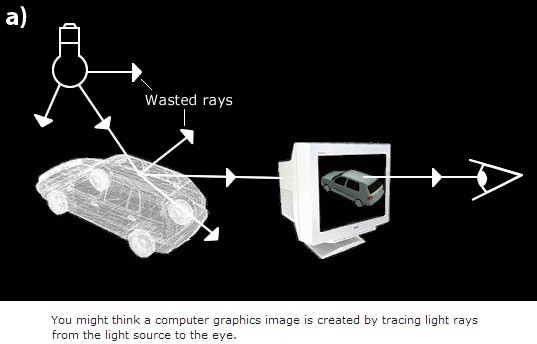
However, it transpires that this is a very inefficient way to generate an image - you would have to generate lots of rays which never reach the eye (the computer viewport) and so never appear in the final image (these "wasted rays" are shown on the image above). As Wikipedia says: "Following rays in reverse is many orders of magnitude more efficient at building up the visual information than would be a genuine simulation of all possible light interactions in the scene, since the overwhelming majority of light rays from a given light source do not wind up providing significant light to the viewer's eye." - see here. It is actually far more efficient to trace rays backwards from the eye, and to see if those rays eventually finish at a light source. In this way, no rays are "wasted":
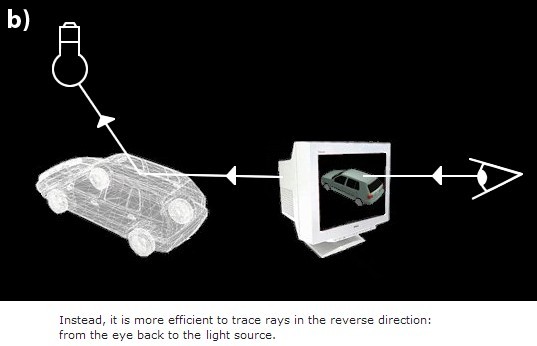
As in the example considered above, "Relativity in a Simulation", reality is created "on demand" only after an observer position is defined. This is the most efficient way of generating a simulation.
It so happens that we can now start to see parallels between these efficient methods of generating reality and the method by which reality is created in quantum mechanics. In the double-slit experiment, for example, a particle appears to take all possible paths before it hits the screen (the double-slit experiment is explained on the page Quantum Mechanics: An Introduction), including passing through both slits at once!
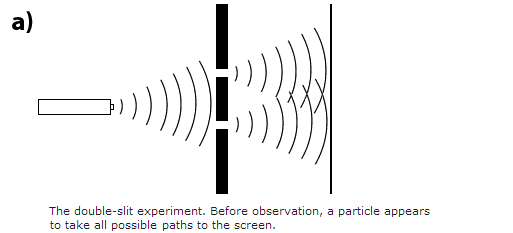
This could be considered the equivalent to the inefficient ray tracing method in which rays are traced along all possible paths from the light source to the eye. However, in quantum mechanics we find that once an observation is made (i.e., once the particle hits the screen) then it appears clear that the particle only passed through one slit. It is though the act of defining an observation position (placing the screen) forced the past history of the particle to take only a single route through a single slit. It is as if the history of the particle is then defined backwards in time along its path once the observation position is defined.
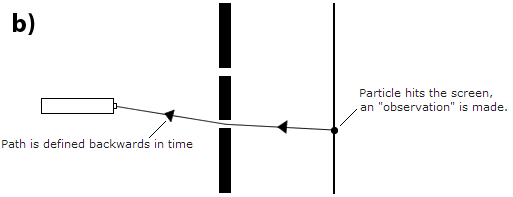
We can now see the similarity between this process and the efficient ray tracing method by which rays are traced backwards from the eye to the light source. It will always be more efficient to generate reality by waiting until an observer position is defined, rather than modelling all possible eventualities. The idea that the rendering techniques (i.e., reality generation) of our most accurate and efficient CGI simulation algorithm has a parallel with the method used by quantum mechanics to generate reality seems to lend some weight to the idea that our reality might, indeed, be simulated!
(For more about this idea of "retrocausality", including a description of the "delayed choice" double-slit experiment, see this New Scientist article, or Stephen Hawking's arXiv paper Cosmology from the Top Down, astro-ph/0305562, which considers retrocausality at the cosmological level: "The histories of the universe depend on what is being measured, contrary to the usual idea that the universe has an objective, observer-independent history".)

The Big Brother Universe
But do we have any evidence that we are living in a computer simulation? Is it just a coincidence that our current popular pastimes - such as watching reality shows like Big Brother and playing God games such as The Sims or the latest astonishing game called Spore - are aimed at producing environments identical to the one in which we find ourselves? Why should that be? It doesn't have to be that way. We love to watch these participants carry out their (often boring!) daily activities, contained within a carefully controlled, closed environment.
There's no reason why these forms of entertainment should be so popular, but the fact of their popularity and their increasing sophistication does seem to provide "evidence-of-a-kind" that maybe 500 to 1,000 years from now we would ourselves be interested in creating simulations of the environment we now inhabit. And that, in turn, might be viewed as providing evidence-of-a-kind that we are, indeed, already participants that ultimate game of Big Brother.
Some tactics have been suggested to ensure we remain participants in any such universe simulation: "You should care less about others ... expect to and try more to participate in pivotal events, be more entertaining and praiseworthy" (see here) - surprisingly similar to the tactics likely to avoid eviction from the Big Brother house!

Russell Brand and me on Big Brother's Big Mouth.
Here are some insights about the Big Brother environment:
- If our universe is a simulation, then the Big Brother house would be a simulation within a simulation. On eviction from the house, the contestant returns to the higher-level simulation. Similarly, if you were woken (evicted) from a particularly vivid dream you would return to the higher-level reality. By analogy, if our universe really is a simulation then maybe when we are evicted (die) we move to the higher-level reality - maybe this could give some solace to those who believe in some form of existence after death! (See this thread on the Big Brother forum).
- Contestants on the show frequently behave unnaturally, aware that they are being watched. In physics we know you cannot make an observation without distorting the experiment. The only way to avoid this would be if the contestants were unaware they were being observed (in a recent reality show, Space Cadets, the participants were completely unaware they were on a show). This would provide an explanation for why we would not be informed if we inhabited a simulation.
- The UK version of the show has a concept of an "Evil" Big Brother who stirs things up within the house to increase the entertainment value. If our universe is simulated then maybe that would provide an explanation for natural disasters and other challenges - they're designed to increase the entertainment value for those viewing the simulation (see the illustration below! Also see this article in which a video game character complains about his hard life, being used for the entertainment of his simulator).
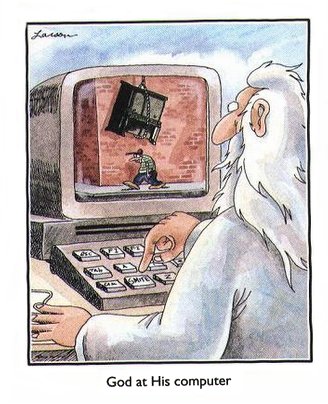
Maybe we should modify Edward R. Harrison's "natural selection" universe theory (described at the top of this page) in which only universes conducive to intelligent life would predominate. Instead we should say that only those universes which support intelligent life which is interested in creating Big Brother-style simulations would predominate.
Wouldn't it be ironic if now by taking a look at ourselves, and our own behaviour, we may indeed - as Stephen Hawking famously said - finally get to "know the mind of God"?
(Footnote: The "Space Cadets" experiment was due to be terminated if the participants figured-out the secret of the hoax. So maybe we shouldn't be trying too hard to uncover these secrets!)
Comments
Here you can add your comments about this
article.
Your comments will appear instantly on this page (underneath this
form):
Great article; had a fun time reading it. - Ivo Jansch, 2nd January 2007
Thanks, Ivo. You run the Simulism wiki? http://www.simulism.org/ I really hope your site is a success as this is such an important topic, and it's only starting to get enough attention. - Andrew Thomas, 2nd January 2007
Yes, I run this wiki and it
would be great if you would contribute.
A quantum physics explanation
for the 'is the father alive in 1990 or not' can be found here:
http://en.wikipedia.org/wiki/Many-worlds_interpretation
If
you see time as a tree where each time you change something in the past, you
create a new branch of space/time, the implication is that you can travel
backwards in time and change something (at which point you create a new branch),
but when you go forward, you go forward along the newly created branch.
A larger problem with time travel, taking our current understanding of
physics into account, is the relationship between matter and energy (e=mc2).
Imagine the universe as a small room with nothing in it but a single ball. If
you would at some point transport the ball to the past, you would end up with a
past that has 2 balls and a future with no balls; to make this work, a
corresponding amount of energy would have to have been transfered from the past
to the future; I haven't found much information about this problem, but I think
it should be taken into account.
(Fun thing is that in The Matrix, to
obey the laws of nature they installed in the matrix, the agents only
materialize 'in place' of an existing person, taking over their avatar; similar
concept) - Ivo Jansch, 3rd January
2007
Hi Ivo, I was thinking last
night that your solution to the "father dead or alive?" problem was similar to
Many Worlds as you have two branches of reality. But to the simulated person it
would appear there was only the one branch. And maybe there IS only one branch
in "reality" - the branch whose state is currently being modelled on your
computer (I don't believe in "Platonic realms" of existence: unless you model a
mode of existence I don't believe it has any form of "reality" - see my page on
"The Mathematical Universe" about Platonism). Interesting stuff! It reveals some
of the issues you'd encounter coding these simulations, and it might also give
clues about the nature of "physical" reality in a simulation.
Your
second point about transporting the ball back to the past also reveals potential
problems with time travel. If you were a software engineer trying to code time
travel into your simulation I think you would encounter endless problems like
that. I suspect you'd probably end up with an ever-increasing number of balls in
the past and a memory leak ... which would eventually crash your simulation.
That's an interesting point you make about The Matrix - they've
obviously thought how to avoid memory leaks by not increasing the total amount
of people in the past! - Andrew Thomas, 3rd
January 2007
This is all pretty heady stuff
for me, but if I may, I'd like to comment.
I have a problem with the
Simulation Argument. Specifically, the idea that since future civilizations will
be far less populous than the simulations they create we are more likely than
not a part of one. This seems to assume not only that future civilizations will
desire to run simulations, but also that if they do the ancestral/historical
simulations will be popular. I believe that if you factor in all possible
futures it seems reasonable to say that there are much much more futures that do
not involve simulation building than those that do. By this reasoning, it would
actually be very unlikely that we are now a part of one.
Does that make
any sense? - Kevin Cantwell, 3rd March
2007
if we are living in the
matrix...
where's the updates??? it's time for some major improvements
around here!!! - jan, 3rd March
2007
Kevin, I also have a bit of a
problem with the prediction of the Simulation Argument that we are more likely
to be living in a simulation than not. However, if you read Nick Bostrom's
original paper carefully his argument is quite ingenious and precise, very hard
to disprove http://www.simulation-argument.com/simulation.html
The way it's phrased it's almost as watertight as a legal document. As Nick
Bostrom always states, the argument has never been successfully refuted.
As to your idea that "there are much much more futures that do not
involve simulation building than those that do", well, you have to consider the
evidence at hand and consider which of those many futures are the most likely.
At the moment, the most likely future seems to be one in which human computing
power continues to grow exponentially, and our interest in creating
sophisticated simulations will also continue. That would appear to be the most
likely of all the many possible futures, so we have to seriously consider the
implications of that. - Andrew Thomas, 4th
March 2007
Try looking at something
closely that you previously disregarded. The drain on the side of a house, for
example, or a rock. As you look closely you will observe features that you
didn't see before. The longer you look, the more features you will see.
Evidently, the simulation initially provides a gross shot of our
surroundings, just enough to fool us into thinking everything is there. It only
provides details when we focus on something.
This method saves huges
amounts of processing time and memory.
The simulation need not keep
track of things you are not presently engaged in. For example, Paris, or the
wall behind you. It only needs to provide you with what you are seeing now.
Similarly, concepts need not be "filled in" until you spend time
thinking about them. And when you do, the concepts you are then ignoring can be
purged from memory. - Bob Sage, 17th March
2007
That's an interesting idea, and I'd agree. It's a similar idea to the notion of a "bounding volume" used to improve the efficiency of computer graphics algorithms: http://en.wikipedia.org/wiki/Bounding_volume Basically, if it's not possible to see an object then you don't have to simulate it. - Andrew Thomas, 17th March 2007
Great article, i want to say that Relativity Theory in fact is incompatible with tense time, because the principle of "The Simultaneously Relativity", that says that 2 event that are simultaneous in a inercial reference frame could not be it in other, destroy the concept of now(imagine two captures witch a cam, with 2 diferents events in a pictures, captured in the same place, the same time, the same angle, the same zoom, the same cam, but a different velocity). - Luchin, 20th April 2007
Thanks for your comment. Yes, I do think special relativity poses a real problem for tensed time, but, as explained in the main article, if you specify an observer position/velocity then that particular observer can have a tensed time all of his own. Basically, time is worked-out for a particular observer. Each observer has his own version of "now" (his own particular visual experience, calculated like a computer graphics viewport) based on his particular position/velocity. So, as I suggest in the main article, "the tensed theory survives". - Andrew Thomas, 20th April 2007
Great website with interesting
ideas and links – really enjoying it!
What seems missing in discussions
about time is the phenomenon of change. I would argue that time is a perception
of rate of change within a system. In your simulation of the football game, the
players process information about, for example, the position of the ball
relative to the other players, and act accordingly; the relative rate of change
within the context provides the timescale for those in the game – as well as
observers watching. There does not need to be any external “clock”. Furthermore,
because of the dynamics of systems, there will be many timescales (as you
suggest in your comments on Relativity). But maybe this just moves the question
into the next court: what is change?
- Jeremy Becker, 20th April 2007
I think you're falling into a bit of a trap, there, rather casually defining time in terms which INCLUDE time. Well, as I said in the main article "rate of change" means how things change with respect to time. So I don't really see how you can define "time" in terms of itself: "Time is change with respect to time", which would lead to the strange idea of time flowing at the rate of one second per second. No? - Andrew Thomas, 20th April 2007
I don't mean one should define time in terms of “time” but in terms of relative motion (“perception of rate of change”). Time arises when things move relative to each other. We measure time by observing regular motions within a context, like the eath's rotation (sundial), wristwatches (hands moving around the face), atomic clocks (absorption spectroscopy of cold atoms) and the speed of light (cosmological time). My point is that time is not a fundamental property but an emergent one, arising out of relative motion. - Jeremy Becker, 21st April 2007
A final note. We can easily imagine universes without time - for example, one that is frozen, motionless; a solid state universe. Or one that is totally empty and void; a perfect vacuum. Or perhaps one that is filled with a singularity of some sort? In other words, time is part of the information content of a universe, concerning its state of order, space, change and motion. - Jeremy Becker, 22nd April 2007
If reality redefines itself to each individual, that would explain a lot. For example lets talk about people who were killed in car wrecks where witnesses said," they just pulled out right in front of that other car!!!" Perhaps in their individual reality it seemed as if the car was farther away than it actually was (I guess I can't say "actually was" beacause actually was for who?). According to the article it's impossible to ever actually completely define or understand reality, correct? Maybe our "reality show producers" just decide to wipe some of us out from time to time, could be for entertainments sake, just by tweaking our realities to combat with others' realities... If that's the case we're walking on far more fragile egg shells than I've ever began to fathom, which leads me to the question; which came first the...?? - Jeremy Butts, 25th July 2007
As you say, Jeremy, we're walking on eggshells because the problem is we don't really have a clear definition of what constitutes our reality ... is it a dream? Will the dreamer wake? Is it a simulation? It sounds like science fiction, but the possibility is all too real. A threat to our very existence, but nobody seems particularly concerned about this! - Andrew Thomas, 25th July 2007
Love the site!! Now for my two
cents; The only problem I have with the simulation argument (brain in the vat,
video game reality, matrix universe in a universe stuff) is the question of
Occams razor; so many universes, which are so complex, in order to explain ours.
Really, it's the only saving grace that allows us to think that we are real.
And, it's a nice thing to shave with. Keep the thoughts coming!!
jr -
John, 14th August 2007
